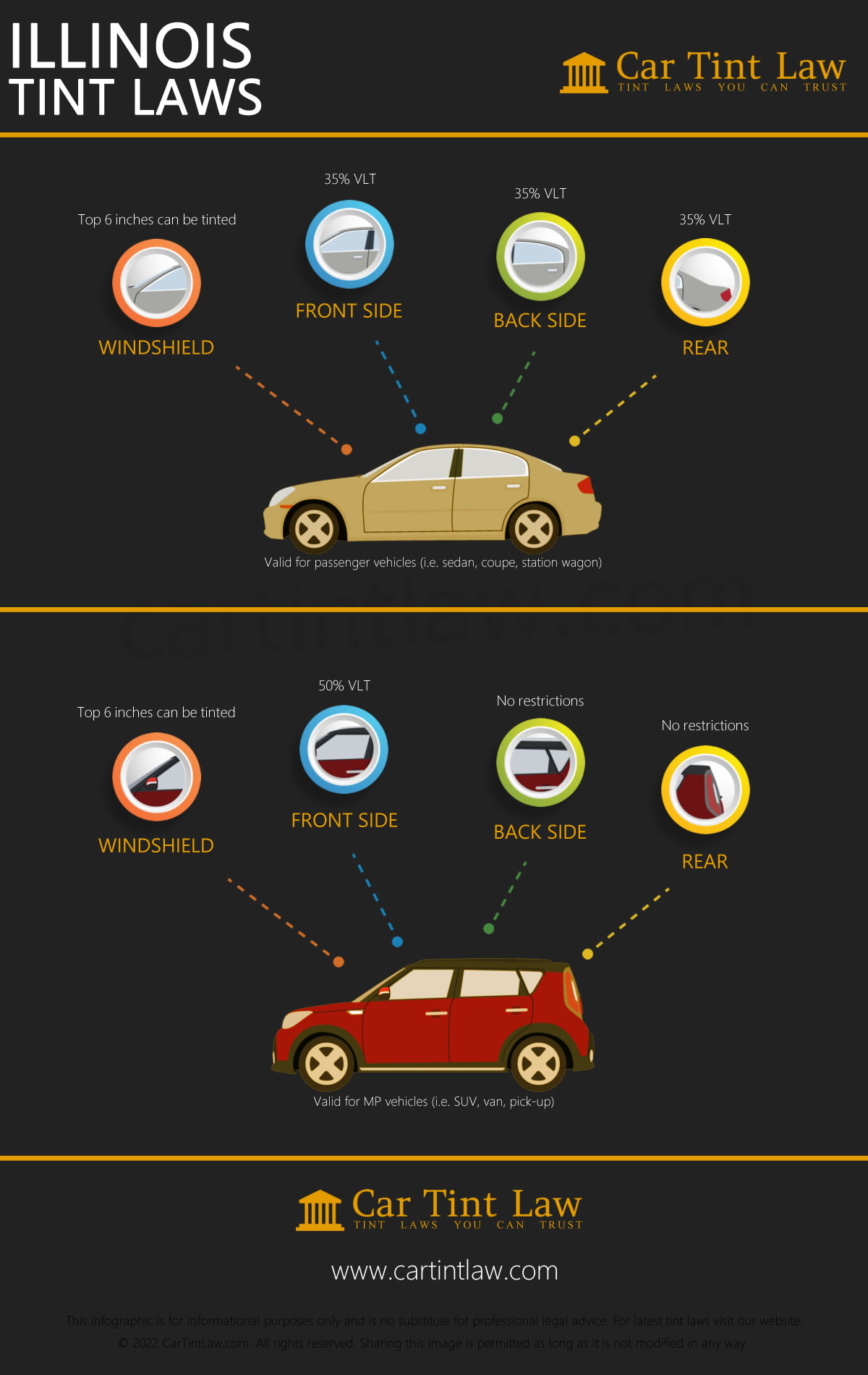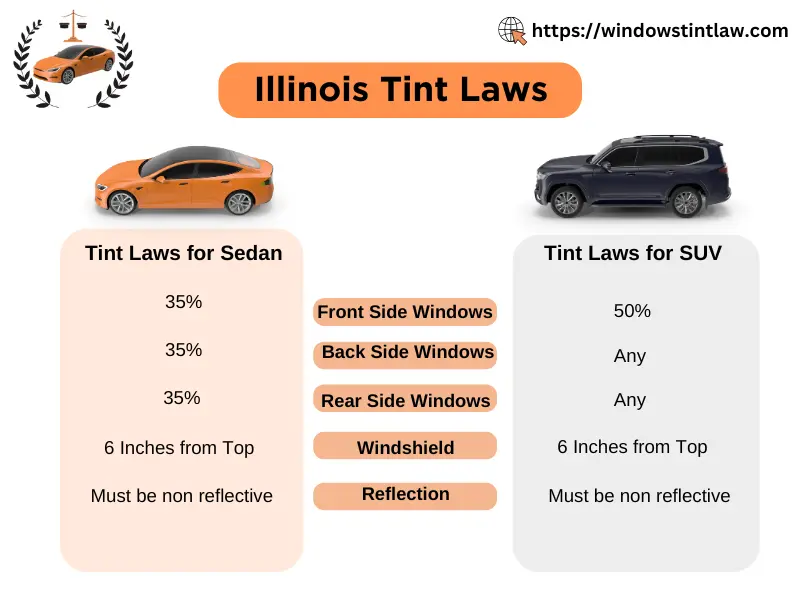Imagine cruising down the scenic roads of Illinois, the sun shining brightly overhead, and the perfect tint on your car windows offering a cool, comfortable ride. But wait—do you know if your window tint complies with Illinois law?
Understanding the state’s tint regulations is crucial for avoiding fines and ensuring your vehicle remains legally compliant. You’ll discover everything you need to know about Illinois tint law, so you can drive with confidence and peace of mind. Whether you’re considering a new tint for your car or just curious about the rules, this guide will help you navigate the dos and don’ts, ensuring you make informed decisions about your vehicle’s appearance and functionality.
Keep reading to uncover all the details that could save you from unnecessary hassles and fines.

Credit: www.cartintlaw.com
Tint Regulations Overview
Understanding the tint regulations in Illinois is crucial for car owners. These laws dictate the level of tint allowed on vehicle windows. Compliance ensures safety and avoids legal issues. This overview covers key aspects of the Illinois tint law.
Understanding Tint Percentage Limits
Illinois law specifies how dark car windows can be. The percentage of light that must pass through the tint is regulated. Front windows must allow more light than rear ones. This ensures visibility and safety for drivers.
Front Window Tint Restrictions
Front windows have stricter tint rules. Illinois requires a minimum of 35% light transmittance. This means the tint must allow at least 35% of light through. It helps ensure clear visibility for drivers.
Rear Window Tint Guidelines
Rear windows have more lenient regulations. Owners can apply darker tints here. The law allows rear window tints to be any percentage. This provides more privacy without compromising safety.
Exceptions To Tint Laws
Some vehicles have exceptions to tint laws. Medical conditions may require special tinting. Owners must provide documentation for these exemptions. Law enforcement checks this documentation carefully.
Penalties For Non-compliance
Non-compliance with tint laws can lead to fines. Vehicle inspections may reveal illegal tinting. Fines can vary based on the severity of the violation. It’s important to adhere to these regulations to avoid penalties.

Credit: www.atrstl.com
Legal Tint Limits
Understanding the legal tint limits in Illinois is crucial for car owners. Tint laws ensure driver safety and consistent visibility on the roads. Different windows have specific regulations that motorists must follow. Here’s a breakdown of the legal tint limits for various car windows in Illinois.
Front Side Windows
In Illinois, front side windows must allow over 35% of light in. This ensures the driver has clear visibility. Police officers need to see inside the vehicle for safety reasons.
Rear Side Windows
Rear side windows have more flexible tint laws. You can tint them darker than front windows. But, a minimum of 35% light transmission is still required. This provides privacy while maintaining safety.
Windshield Tint
Windshield tinting has stricter rules. Only the top six inches of the windshield can have tint. The tint must be non-reflective. This reduces glare while maintaining a clear view of the road.
Rear Window Tint
The rear window can be tinted with the same flexibility as the rear side windows. Ensure it allows at least 35% of light through. A clear rear view is essential for safe driving.
Exemptions And Special Cases
Illinois tint law includes exemptions for certain vehicles. Medical conditions may allow darker tints for drivers. Law enforcement and emergency vehicles often receive special tint permissions.
When considering window tinting laws in Illinois, it’s essential to understand the exceptions and special cases that can affect you. Not everyone fits the standard mold, and the law provides leeway for certain situations. These exceptions can make a significant difference, especially if you have unique needs or circumstances. ###Medical Exemptions
Illinois recognizes that some individuals have medical conditions that require special consideration when it comes to window tinting. Imagine you’re someone with a condition that makes you sensitive to sunlight. The state allows for medical exemptions so you can tint your windows more than usually permitted. To apply for a medical exemption, you’ll need documentation from a licensed physician. This paperwork must clearly state the medical necessity for increased tint. Consider it a lifeline for those who need it, offering both comfort and safety. ###Commercial Vehicles
Commercial vehicles often have different needs compared to personal vehicles. If you own a business, you know the importance of branding and security. Commercial vehicles are allowed a different level of tinting, acknowledging these unique needs. The law permits more flexibility for these vehicles, often allowing darker tints. This is particularly beneficial for vehicles that transport valuable goods or equipment. If you’re a business owner, this exception can add a layer of security and privacy for your operations. Understanding these exemptions can be a game-changer. Have you ever thought about how these laws could benefit you or your business? Knowing your rights and options is crucial. It allows you to make informed decisions while staying compliant. So, next time you think about tinting, consider if you fall into one of these special categories. It might just be the advantage you’ve been looking for.
Credit: windowstintlaw.com
Consequences Of Non-compliance
Understanding the consequences of non-compliance with the Illinois Tint Law is crucial. Violating these regulations can lead to significant repercussions. Drivers may face financial penalties and complications with their insurance. Knowing the risks helps ensure compliance and avoid unnecessary headaches.
Fines And Penalties
Non-compliance with tint regulations attracts fines. These can range from $50 to $500. Repeat offenders might face higher penalties. Law enforcement can issue tickets during routine checks. Penalties can increase if multiple violations occur. It’s important to ensure your vehicle meets legal standards.
Impact On Insurance
Illegal tint can impact your insurance rates. Insurance companies may consider it a risk factor. They could potentially raise premiums due to non-compliance. Illegal modifications might void certain claims. This can lead to financial stress during accidents. Ensuring legal compliance avoids unnecessary complications.
Tips For Choosing Legal Tint
Choosing the right window tint for your car in Illinois requires understanding the state’s tint laws. Ensuring compliance with these laws helps avoid fines and maintains road safety. This guide offers practical tips for selecting a legal tint that fits your needs.
Selecting The Right Shade
Illinois law regulates the darkness of window tints. Front side windows must allow over 35% light in. Rear side windows have more flexibility. Knowing this helps in choosing the correct shade. Consider how much privacy and UV protection you want. Lighter shades provide better visibility. Darker shades offer more privacy but might limit visibility at night. Balance these factors according to your driving conditions.
Professional Installation
Professional installation ensures compliance with tint laws. Experts know the legal requirements and apply tints accurately. They use quality materials that last longer. This prevents peeling or bubbling. A professional job enhances the car’s appearance. It also ensures the tint does not interfere with window functions. Choose a reputable installer with positive reviews. Ask about their experience with Illinois tint laws. This guarantees your tint is both legal and durable.
Staying Updated With Changes
Illinois tint law changes frequently. Staying updated helps avoid fines and ensures compliance. Knowing the latest rules keeps your vehicle legally tinted.
Staying informed about changes in the Illinois Tint Law is crucial for any vehicle owner in the state. With laws evolving, keeping up-to-date ensures you’re always on the right side of the law and can avoid unexpected fines. By actively monitoring updates, you can drive with peace of mind, knowing your vehicle complies with current regulations.Monitoring Legislation
Keeping an eye on legislative changes might sound daunting, but it’s easier than you think. Set a reminder to check the Illinois General Assembly’s website periodically. This site often lists updates on any changes to state laws, including those related to vehicle tinting. Consider setting up Google Alerts for keywords like “Illinois Tint Law” or “vehicle tint regulations.” This way, you’ll receive notifications directly to your inbox whenever there’s news or changes regarding tint laws in Illinois.Resources For Updates
Several resources can help you stay informed about tint law changes. The Illinois Secretary of State’s website is a reliable source for comprehensive updates and official announcements. You might also want to follow local auto forums or social media groups. Many enthusiasts share insights and updates about tint laws, sometimes even before they’re widely publicized. Lastly, connect with local tinting businesses. They often receive updates from industry associations, and they can provide firsthand information on compliance requirements. Have you ever considered how easy it is to ask your installer about recent law changes during your next visit? Staying informed isn’t just about avoiding fines; it’s about ensuring you make informed decisions about your vehicle. What steps will you take today to stay updated?Frequently Asked Questions
What Is The Darkest Legal Tint In Illinois?
Illinois allows a maximum of 35% tint darkness for passenger vehicles. SUVs and trucks can have any darkness on rear windows. Front side windows require at least 35% light transmission. Ensure compliance with state regulations for safety and legality.
Should I Get 35 Or 20 Tint?
Choose 35 tint for more visibility and a lighter shade. Opt for 20 tint for darker, privacy-focused windows. Consider local tinting laws, personal preferences, and visibility needs before deciding. Both options offer UV protection and enhance vehicle aesthetics.
Is 30 Percent Tint Legal In Illinois?
In Illinois, 30 percent tint is legal for rear windows. Front side windows must allow over 35% light. Compliance with laws is crucial to avoid penalties. Always verify local regulations for updates.
In What State Is 20% Tint Legal?
20% tint is legal in states like California and Texas for rear windows. Check local laws for front windows. Always ensure compliance with state-specific regulations to avoid fines.
Conclusion
Understanding Illinois tint law is crucial for drivers. It ensures road safety and compliance. Knowing the rules helps you avoid fines. Keep your vehicle within legal limits. Follow guidelines for window tinting. It’s essential for a smooth driving experience. Make informed choices with your car modifications.
Stay updated on changes in the law. Protect yourself and your passengers. Enjoy driving without legal hassles. Follow these tips and drive confidently. Stay safe and informed on the road. Your compliance keeps you and others safe. Always prioritize safety and legality in vehicle changes.
